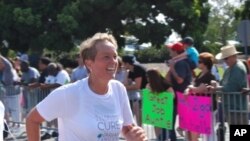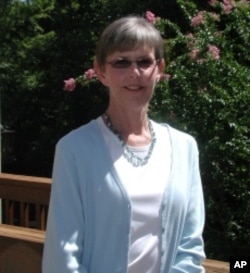Ovarian cancer is called a “silent killer” because by the time symptoms appear and diagnosis is made, it is generally too late for a cure.
Last year, 22,000 women were diagnosed with the disease in the United States; 14,000 of them died.
Laura Shawver, a scientist cancer researcher and commercial drug developer, is fighting back by offering ovarian cancer patients a molecular profile or blueprint of their tumor.
Shawver, a cancer survivor who has been in remission since 2006, had the same initial treatment as every ovarian cancer patient.
“The the same treatment that’s been around for at least 30 years," she says. "We all get surgery and we all get chemotherapy. Most people have a response, and we think we’re cured.”
Shawver is one of the few lucky ones. Ovarian cancer returns in 75 percent of patients.
“When we recur that’s when the guesswork comes in.” Shawver says that’s because ovarian tumors differ so widely from each other and respond differently to drugs. So, women end up going through round after round of different chemotherapy drugs. “It’s a random selection and, unfortunately, that means that the patient frequently gets toxicity without benefit.”
That has been Sheila Connor’s experience. She was diagnosed with late-stage ovarian cancer in 2007. After initial surgery and chemotherapy, the cancer returned four times over four years.
“The longest remission I had was about eight months,” says Connor.
She tried a battery of drugs. One would work for a time. Another would complicate her illness. “All the skin on my hands and feet peeled off, and I had mouth sores from it that I had to be hospitalized because I couldn’t eat. I couldn’t eat anything without pain medicine.”
Connor recently left a clinical trial because her cancer had progressed. She's decided to stop treatment.
Shawver believes the one-size-fits-all treatment approach doesn’t work. “There’s probably a better choice when they recur - and the chemo agents that are available, the molecular targeted agents that are available, the clinical trials that are available - should all be taken into consideration when faced with recurrent disease.”
In 2007, Shawver started the Clearity Foundation. The nonprofit offers ovarian cancer patients a molecular profile, or blueprint, of their tumor. That helps target drug therapy to a specific tumor.
Profiles are available for other cancers, but this is the first time it’s being applied to ovarian cancer.
Clearity compares the diseased ovarian tumor to others in its database. That suggests which of the dozen or so drugs regularly used for ovarian cancer might be most effective, based on their success in similar cases.
The foundation also screens for biological markers, which can indicate how a tumor will respond to certain chemotherapy agents. This opens options to try other cancer-fighting drugs.
That profiling wasn’t available when Sheila Connor's cancer first recurred. She says it’s a tool that can help patients make informed decisions. “If you had some idea, whether you would respond to these drugs you could try something else, try another standard drug and then if the other standard drugs don’t work, then I know that I need to get on a clinical trial.”
That is how Shawver is determined to change the way ovarian cancer is treated: one patient at a time. “In order to for the paradigm to really shift, we need for every woman who has recurring ovarian cancer to be willing to get her tumor profiled, to be willing to get on the right clinical trial and to really educate themselves about what are the treatment options.”
Shawver says this approach not only improves the quality of life for women with recurring ovarian cancer, it can also lead to the development of specific new drugs for the often deadly disease.

